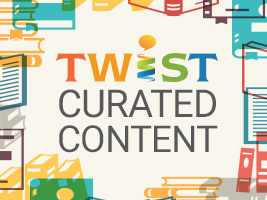Curated Industry Content for the week of 09/21/15
 Every Monday we curate a number of articles and blog posts that have relevance to members of the eLearning Guild Community, and to the learning and performance field as a whole. Each piece of content that we share includes a brief introduction from the member of the Guild Community sharing why they think the content is important.
Every Monday we curate a number of articles and blog posts that have relevance to members of the eLearning Guild Community, and to the learning and performance field as a whole. Each piece of content that we share includes a brief introduction from the member of the Guild Community sharing why they think the content is important.
Here’s the content for this week:
The Unexpected Influence of Stories Told at Work by Francesca Gina, Harvard Business Review
“Behavior can be contagious even when it’s simply described in a story.” Humanbeings have been learning from story for thousands of years and “story” is once again regaining attention as a learning medium in organization. Content, connection, association to prior learning, and emotion charge a story making it not only memorable but appear to make it impact behaviors. Spoiler alert – Learning of successful cheating can lead to more cheating. What positive behaviors can be made contagious in organizations through story? – Mark Britz
The Lack of Diversity in Stock Images Hurts Your eLearning—and What to Do About It by Trina Rimmer
Stock images. If you’re responsible for developing elearning, chances are you’ve used them. But if you take a step back and look at the image selection as a whole, the lack diversity becomes apparent. This excellent article explores this problem, and provides great solutions we can all apply to our work. – David Kelly
Do Babies Know When They’re Skyping? by Adrienne LaFrance
Interesting research into the impact of technology on the developing infant brain and understanding of presence. According to the findings, children can recognize live interaction vs. that of video (think skyping with grandparents vs. that of childrens TV programming). An emtion connection can be made or maintained through a screen. – Mark Britz
Some Clever Chap Came Up With An Ingenious Idea To Stop People Littering by Lewis Potton
In our focus on learning, we sometimes forget that most organizational learning programs have a goal, a problem to be solved. Approaching projects with the mindset of “what problem do we need to solve” instead of working within the strict paradigm of “what do people need to learn?” can often result in interesting designs and solutions. This article is a case in point. Rather than focusing on educating people on the importance of not littering with cigarette butts, a solution was developed that served the ultimate goal in a novel and interesting way. – David Kelly
The Future of Work is Flexible Talent by Simon Terry
In this short post Simon points us to an unknown but trending future that sees that organizational talent will be and must be open to other activities beyond one’s job role. Doing so would aid in overall satisfaction, loyalty and therefore retention. Furthermore it helps the organization show it’s true personality to the world which has benefits beyond profits. – Mark Britz
Glen Keane – Step into the Page
If you want to understand how technology is changing the way we live and learn, one of the best ways things to do is explore how it is transforming something we understand in today’s context. Take something as ubiquitous as drawing. How does the concept of drawing change when the canvas is a completely three-dimensional space? And as Glen Keane asks in this brief but thought-provoking video, “What does it mean to storytelling?”
What are you reading?
If you have an article, blog post, or other resource that you think we should consider sharing in a future Curated Industry Content post, please feel free to send a link to the resource to David Kelly along with a few sentences describing why you think the resource is valuable.

Leave a Reply